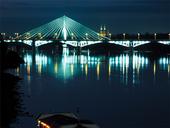The beginnings of settlement in the Valley of Warsaw are dated to the tenth century. At the end of the thirteenth century, in the area where the Royal Castle stands, a new princely town was founded, that is, today’s Warsaw.
The earliest note about Warsaw appears in written records from 1313. After Mazovian Princes had died heirless, Mazovia was incorporated into the Polish Crown.
Since 1569, it had been a place where sessions of the Sejm of the Joint Polish Lithuanian Republic were held.
After the fire of the Wawel Castle, King Sigismunt Waza III transferred permanent royal residence, courts and the Crown’s offices from Cracow to the extended Warsaw’s Royal Castle.
In the thirteenth century, wars, disturbances and plagues brought on a slump in the economic growth of the town. In years 1655 – 1658 alone was Warsaw besieged, conquered and occupied three times by the Swedes and Tranylvanian troops. In the Sas dynasty reign, after the political situation had settled down, Warsaw regained its status of an important cultural centre. The next golden age of the capital city spins the years of the reign of the last King of Poland, that is, Stanislaw August Poniatowski.
After the third partition of Poland, in 1795, the country disappeared from the map of Europe for 123. Through this period Warsaw was downgraded to the rank of the Russian province.
Despite a disadvantageous political atmosphere, the town and its industry kept developing. In the years 1840 – 1848, the first railway connecting Warsaw with Vienna was founded. In 1864, the first permanent bridge across the river Vistula came into use, and in 1875, a railway bridge was constructed.
Between 1851 and 1855, the first waterworks were built; in years 1881 – 1886 – the first sewer system appeared. In 1856, citizens of the capital city could use gas, and in 1881, the first telephone exchange was built. In 1882, a regular public horse-tram transport was introduced and replaced by electrical one in 1907.
In 1918, Warsaw became the capital city of reborn Poland. The process of tidying it up became especially intense during the presidency of Stefan Starzynski. It was however brutally interrupted by the outbreak of World War II and the German occupation.
Warsaw was defended till 28 September 1939. Again, the city became the main centre of Resistance, conspiracy and cultural and academic life. The April of 1943 witnessed the outbreak of an uprising in the walled off Jewish Ghetto. After it had come to an and, the Jewish quarters with half a million people ceased to exist. On 1 August 1944, the Warsaw uprising organised by the Home Army broke out. The Honorary Capitulation Act was signed on the 2 October. After the uprising had been quashed, Warsaw was condemned to annihilation. Its citizens were exiled and transported to concentration camps. The Germans started to destroy the city through systematic bombardments. As a result, 650 000 people were killed and 84 per cent of buildings were destroyed.
The process of rebuilding Warsaw started immediately in 1945. Today the capital city of Poland, which was to be erased from the map of Europe, is reborn and throbbing with life.
